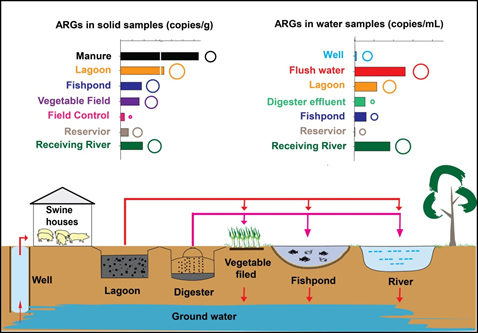Swine feedlots are widely considered as a potential hotspot for promoting the dissemination of antibiotic resistance genes (ARGs) in the environment. ARGs could enter the environment via discharge of animal wastes, thus resulting in contamination of soil, water, and food. We investigated the dissemination and diversification of 22 ARGs conferring resistance to sulfonamides, tetracyclines, chloramphenicols, and macrolides as well as the occurrence of 18 corresponding antibiotics from three swine feedlots to the receiving water, soil environments and vegetables. Most ARGs and antibiotics survived the on-farm waste treatment processes in the three swine farms. Elevated diversity of ARGs was observed in the receiving environments including river water and vegetable field soils when compared with respective controls. The variation of ARGs along the vertical soil profiles of vegetable fields indicated enrichment and migration of ARGs. Detection of various ARGs and antibiotic residues in vegetables fertilized by swine wastes could be of great concern to the general public. This research demonstrated the contribution of swine wastes to the occurrence and development of antibiotic resistance determinants in the receiving environments and potential risks to food safety and human health.
Livestock operations are known to harbor elevated levels of antibiotic resistance genes (ARGs) that may pose a threat to public health. Broiler feedlots may represent an important source of ARGs in the environment. However, the prevalence and dissemination mechanisms of various types of ARGs in the environment of broiler feedlots have not previously been identified. We examined the occurrence, abundance and variation of ARGs conferring resistance to chloramphenicols, sulfonamides and tetracyclines in the environments of two representative types of broiler feedlots (free range and indoor) by quantitative PCR, and assessed their dissemination mechanisms. The results showed the prevalence of various types of ARGs in the environmental samples of the broiler feedlots including manure/litter, soil, sediment, and water samples, with the first report of five chloramphenicol resistance genes (cmlA, floR, fexA, cfr, and fexB) in broiler feedlots. Overall, chloramphenicol resistance genes and sulfonamides sul genes were more abundant than tetracyclines tet genes. The ARG abundances in the samples from indoor boiler feedlots were generally different to the free range feedlots, suggesting the importance of feeding operations in ARG dissemination. Pearson correlation analysis showed significant correlations between ARGs and mobile genetic element genes (int1 and int2), and between the different classes of ARGs themselves, revealing the roles of horizontal gene transfer and co-selection for ARG dissemination in the environment. Further regression analysis revealed that fexA, sul1 and tetW could be reliable indicator genes to surrogate anthropogenic sources of ARGs in boiler feedlots (correlations of fexA, sul1 and tetW to all ARGs: R = 0.95, 0.96 and 0.86, p < 0.01). Meanwhile, significant correlations were also identified between indicator ARGs and their corresponding antibiotics. In addition, some ARGs were significantly correlated with typical metals (e.g., Cu, Zn, and As with fexA, fexB, cfr, sul1, tetW, tetO, tetS: R = 0.52-0.71) and some environmental parameters (e.g., TOC, TN, TP, NH3-N with fexA, fexB, cfr, sul1, tetW, tetO, tetQ, tetS: R = 0.53-0.87) (p < 0.01). Further redundancy analysis demonstrated that the distribution and transportation of ARGs from the boiler feedlots to the receiving environments were correlated with environmental variables. The findings highlight the contribution of some chemicals such as antibiotics and metals to the development of ARGs in broiler feedlots environments; and the observed ARG dissemination mechanism in the broiler feedlots facilitates the development of effective mitigation measures.

Figure 3. Discharge of swine wastes risks water quality and food safety.

Figure 4. Dissemination of ARGs in Chicken farms.
References:
(1) He LY, Ying GG, Liu YS, Su HC, Chen J, Liu SS, Zhao JL (2016) Discharge of swine wastes risks water quality and food safety: Antibiotics and antibiotic resistance genes from swine sources to the receiving environments. Environment International 2016, 92/93, 210-219.
(2) He LY, Liu YS, Su HC, Zhao JL, Liu SS, Chen J, Liu WR, Ying GG (2014) Dissemination of antibiotic resistance genes in representative broiler feedlots environments: Identification of indicator ARGs and correlations with environmental variables. Environmental Science & Technology 48, 13120-13129.
(3) Zhou LJ, Ying GG, Liu S, Zhang RQ, Lai HJ, Chen ZF, Pan CG (2013) Excretion masses and environmental occurrence of antibiotics in typical swine and dairy cattle farms in China. Science of the Total Environment 444, 183-195.